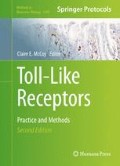Abstract
Toll-like receptors are type I membrane proteins and bind other membrane proteins often via a specific interaction between transmembrane domains. The co-immunoprecipitation assay is a widely used biochemical technique for assessing interactions among proteins in cell lysates or tissue extracts. By isolating a native protein complex with a specific antibody against a protein of interest, followed by western blotting with an antibody for a binding partner, the co-immunoprecipitation assay can be used to confirm a putative interaction between two proteins. The co-immunoprecipitation assay can also be combined with a proteomics approach such as protein mass spectrometry to build an interactome of a target protein. Despite its usefulness and popularity to probe protein interactions within complex biological samples, the co-immunoprecipitation assay of membrane proteins is rather tricky, often resulting in false data. Here, we describe a co-immunoprecipitation method for analyzing interactions between toll-like receptors and other membrane proteins, using the interaction between TLR9 and UNC93B1 as an example. Especially, we describe an optimal cell lysis and sample preparation method to preserve protein interactions mediated by transmembrane domains.
Access this chapter
Tax calculation will be finalised at checkout
Purchases are for personal use only
References
Kawai T, Akira S (2010) The role of pattern-recognition receptors in innate immunity: update on Toll-like receptors. Nat Immunol 11:373–384
Kang JY, Lee JO (2011) Structural biology of the Toll-like receptor family. Annu Rev Biochem 80:917–941
Brinkmann MM, Spooner E, Hoebe K et al (2007) The interaction between the ER membrane protein UNC93B and TLR3, 7, and 9 is crucial for TLR signaling. J Cell Biol 177:265–275
Tabeta K, Hoebe K, Janssen EM et al (2006) The Unc93b1 mutation 3d disrupts exogenous antigen presentation and signaling via Toll-like receptors 3, 7 and 9. Nat Immunol 7:156–164
Casrouge A, Zhang SY, Eidenschenk C et al (2006) Herpes simplex virus encephalitis in human UNC-93B deficiency. Science 314:308–312
Kim YM, Brinkmann MM, Paquet ME (2008) UNC93B1 delivers nucleotide-sensing toll-like receptors to endolysosomes. Nature 452:234–238
Kim J, Huh J, Hwang M et al (2013) Acidic amino acid residues in the juxtamembrane region of the nucleotide-sensing TLRs are important for UNC93B1 binding and signaling. J Immunol 190:5287–5295
Huh JW, Shibata T, Hwang M et al (2014) UNC93B1 is essential for the plasma membrane localization and signaling of Toll-like receptor 5. Proc Natl Acad Sci U S A 111:7072–7077
Lee BL, Moon JE, Shu JH et al (2013) UNC93B1 mediates differential trafficking of endosomal TLRs. Elife 2, e00291
Hu CD, Chinenov Y, Kerppola TK (2002) Visualization of interactions among bZIP and Rel family proteins in living cells using bimolecular fluorescence complementation. Mol Cell 9:789–798
Pollok BA, Heim R (1999) Using GFP in FRET-based applications. Trends Cell Biol 9:57–60
Chan FK (2004) Monitoring molecular interactions in living cells using flow cytometric analysis of fluorescence resonance energy transfer. Methods Mol Biol 261:371–382
Issad T, Jockers R (2006) Bioluminescence resonance energy transfer to monitor protein-protein interactions. Methods Mol Biol 332:195–209
Regan JW, Barden N, Lefkowitz RJ et al (1982) Affinity chromatography of human platelet alpha 2-adrenergic receptors. Proc Natl Acad Sci U S A 79:7223–7227
Acknowledgement
This work was supported by the grant from National Research Foundation of Korea (NRF-2013R1A1A2074573) and BK21 Plus (10Z20130012243).
Author information
Authors and Affiliations
Corresponding author
Editor information
Editors and Affiliations
Rights and permissions
Copyright information
© 2016 Springer Science+Business Media New York
About this protocol
Cite this protocol
Lee, YR., Kang, W., Kim, YM. (2016). Detection of Interaction Between Toll-Like Receptors and Other Transmembrane Proteins by Co-immunoprecipitation Assay. In: McCoy, C. (eds) Toll-Like Receptors. Methods in Molecular Biology, vol 1390. Humana Press, New York, NY. https://doi.org/10.1007/978-1-4939-3335-8_7
Download citation
DOI: https://doi.org/10.1007/978-1-4939-3335-8_7
Published:
Publisher Name: Humana Press, New York, NY
Print ISBN: 978-1-4939-3333-4
Online ISBN: 978-1-4939-3335-8
eBook Packages: Springer Protocols

